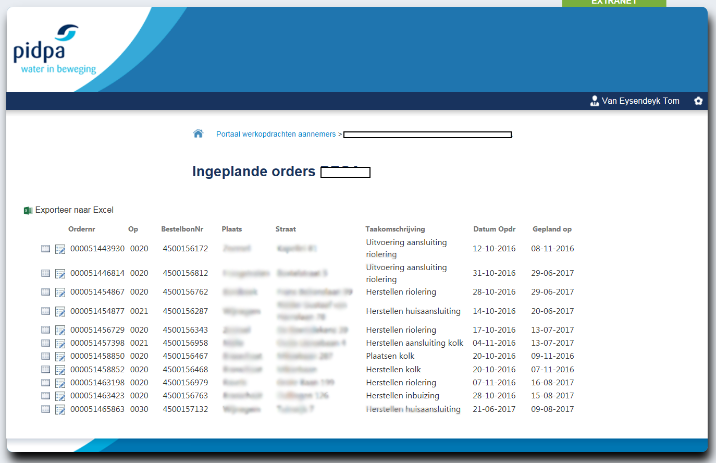
About Pidpa
- Water company
- Approximately 700 employees
- Provides around 500,000 customers or 1.2 million inhabitants of drinking water in the Belgian province of Antwerp
- Extensive sewerage activity
- Pipeline of approximately 12,700 km
- IT service support of 30 employees
Looking for an easy way to integrate
Pidpa has many internal and external stakeholders such as employees, suppliers, customers and board members. As a result, the organization has a lot of data and processes to manage in different systems. For example, customer data, orders and HR data are managed in SAP, documents are processed in the eDOCS DMS and geographical information is stored in GIS (ESRI). Pidpa has about 700 employees. To work even more efficiently, the company decided a few years ago to build an intranet based on SharePoint technology. Subsequently, an extranet was set up with secure access for external partners and board members to collaborate on projects and orders.
Pidpa was convinced that the web portals should contain integrated information. Namely, by collecting all relevant data, users have instant access to the information they need without losing time whilst searching for this information. Therefore, the question was “How do you integrate documents from the eDOCS DMS with data from the SAP and MS / SQL databases?”
Pidpa initially started with custom programming but soon realized that this was very time-consuming and complicated. Moreover, it required a high level of technical expertise. Another disadvantage was that this situation allowed limited possibilities for standardization and therefore there was hardly any reuse. That is why Pidpa started looking for a more suitable solution.
The requirements for Pidpa were clear. They wanted a tool that they could use and manage independently. Moreover, guidance, support and accessibility of the supplier were also important aspects in their choice. While they were exploring alternatives in the market, Pidpa attended a Beginner Training from Ometa. This session showed them how to integrate systems through configuration. The training was a revelation and Pidpa decided to take the test.

A stable DIY integration tool
When it comes to technical choices, Pidpa always strives to make stable decisions for a long-term solution. That is why the IT department finds it very important to make informed choices. In this context, being able to start small to see if the expectations are actually fulfilled plays an important role. While experimenting with a new technology, it is also important for Pidpa to have close contact with the technology supplier. After all, it is not just about what the software can do, but also about how the relationship with the provider is. This is how Pidpa started a trial license. Also in terms of investment, it was important to be able to start small and then grow. This way, the management could be convinced systematically.
Pidpa strives to realize 80% independently with the Ometa framework. This gives them freedom of choice and it enables them to change things quickly and flexibly. For complex issues they can of course rely on the support and expertise of Ometa. Thanks to the Ometa framework, Pidpa found a stable solution that meets their needs. They found a simple way to integrate with SAP, eDOCS and AD. Ometa also offers various other integration options thanks to the built-in OData service. This offers them a uniform working method, which is a great advantage.
In addition, the tool is easy to use because it is only a matter of configuration. As a result, for some solutions the development time is reduced from weeks to days. Finally, Pidpa now has a tool that they can manage and use independently. This gives them a lot of freedom and flexibility to change or adjust their portals and solutions.
Because Ometa offers a no-code platform, we can work with the tool ourselves. That’s important to us because next to autonomy, it also offers us more speed and flexibility (Tom Van Eysendeyk, Pidpa)

Improved internal communication
With around 700 employees, Pidpa has the constant need to optimize communication. For example, a few years ago the water company made the intranet much more dynamic and ensured that the quality and speed of information was increased. Initially, there was a huge amount of e-mail traffic within the organization, including e-mails to large groups of people. That is why Pidpa decided to make news reports and internal information such as emergency messages and announcements available via an integrated intranet. Through the new intranet, employees can make holiday requests and sickness notifications and these actions immediately pushed towards the colleagues of HR.
Thanks to the direct integration with SAP, an efficient way to follow up on all kinds of requests became possible and different actions are now managed in a uniform manner. The intranet is accessible to all employees. For the workers who are always on the road, the intranet is made available on tablets. This last example is closely related to the fact that Pidpa has a diverse staff park. This means that there are employees who are very familiar with SAP, but at the same time there are also many employees who have no experience with the system. For the latter group, the integrated intranet means that they can receive information from and can write back to SAP in realtime via user-friendly SharePoint portals.
A very striking example is the registration of deviations in SAP. Deviations can be seen as defects or malfunctions (e.g. to a sewer system). Previously, it often occurred that employees had no access and / or knowledge of SAP. Consequently, a manual data transfer was necessary with the additional disadvantage that the data was not always up to date. This has been solved because employees can now register and update deviations in SAP via simple web forms.
Collaboration with external stakeholders
In order to collaborate better with external stakeholders such as partners and directors and to manage projects and orders efficiently, Pidpa has developed a sophisticated extranet. Within this context, they use Ometa to combine the right data from different data sources. A good example of this is the project portal.
Pidpa has about 300 sewerage projects and about 1200 distribution projects. For each project there are several people involved who each prepare and share documents. An important side note here is that a large number of these documents are created by external parties. For the larger sewerage projects we talk about 850 documents per project. The exchange of this large number of documents was initially done in various ways: on paper, via USB sticks, e-mails, Dropbox, et cetera. This created many challenges in terms of overview and it was not always easy to obtain the correct and latest version of documents. The completeness of information was sometimes also compromised.
As a result, the objective was threefold: to improve communication between stakeholders, to optimize the information structure and to reduce e-mail traffic. Pidpa was able to realize this thanks to a project portal that is connected to SAP in real time. With this web portal, the water company now has a uniform way of working together with all the different external parties where each party can work from his / her role. By adding Nintex workflows, Pidpa can steer and follow up the projects in a simple way. An additional advantage is that, thanks to Ometa’s technology, project portals are fully set up and automatically created based on state changes in SAP. This means that setting up a new project portal happens entirely independent of the Pidpa ICT service.
Another example is the order portal with which Pidpa is able to collaborate efficiently with contractors. Within the portal, orders are made available for contractors and contractors can also return documents. The status of every order managed by a contractor is transferred to SAP in real time. This way of working has a positive impact on the planning of the water company.

Picture: suppliers can consult their planned orders via webportals that are connected realtime with Pidpa’s SAP.
In addition to providing us with the right technology, Ometa also encourages us to learn from solutions that they have created for other customers. In this way, we can reuse these solutions for our own benefit. This provides us with knowledge sharing and it helps us to build new solutions even faster. (Tom Van Eysendeyk, Pidpa)